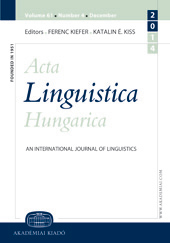The auxiliary + infinitive construction in Hungarian
The auxiliary + infinitive construction in Hungarian
Author(s): Gábor Tolcsvai NagySubject(s): Semantics, Finno-Ugrian studies
Published by: Akadémiai Kiadó
Keywords: auxiliary; infinitive; composite structure; profile determinacy; subjectification; grounding;
Summary/Abstract: This paper gives a descriptive overview of the prototypical Hungarian auxiliary+infinitive construction, discussed in the framework of functional cognitive grammar worked out by Ronald Langacker and in the grammaticalization theory for auxiliaries by Bernd Heine. The degree of grammaticalization seems to have a greater role in the construction than suggested in the previous literature, while Langacker’s theory (fit for English) needs some modification. In the construction discussed here, the auxiliary profiles a process, and (future) tense or modality. The infinitive accounts for most of the semantic content of the overall event structure. Both component structures contribute equally to the profile of the construction (the composite structure), in a complementary way, in contrast with a prototypical composite structure. I assume that the Hungarian auxiliary serves the function of imposing temporality on a nontemporal infinitive, and also that of the grounding predication, which marks a departure from Langacker’s English model. The Hungarian grounding predication (the auxiliary) and its head (the infinitive) do not belong to the same grammatical class, only the auxiliary+infinitive composite structure construes a process temporally. Also, degrees of subjectification contribute to types of construal, yielding a dimension of variation that cannot be derived from the deontic/epistemic distinction. Just like the semantic functions of the auxiliaries, subjectification and grounding show gradual characteristics.
Journal: Acta Linguistica Hungarica (Since 2017 Acta Linguistica Academica)
- Issue Year: 57/2010
- Issue No: 1
- Page Range: 143-164
- Page Count: 22
- Language: English

